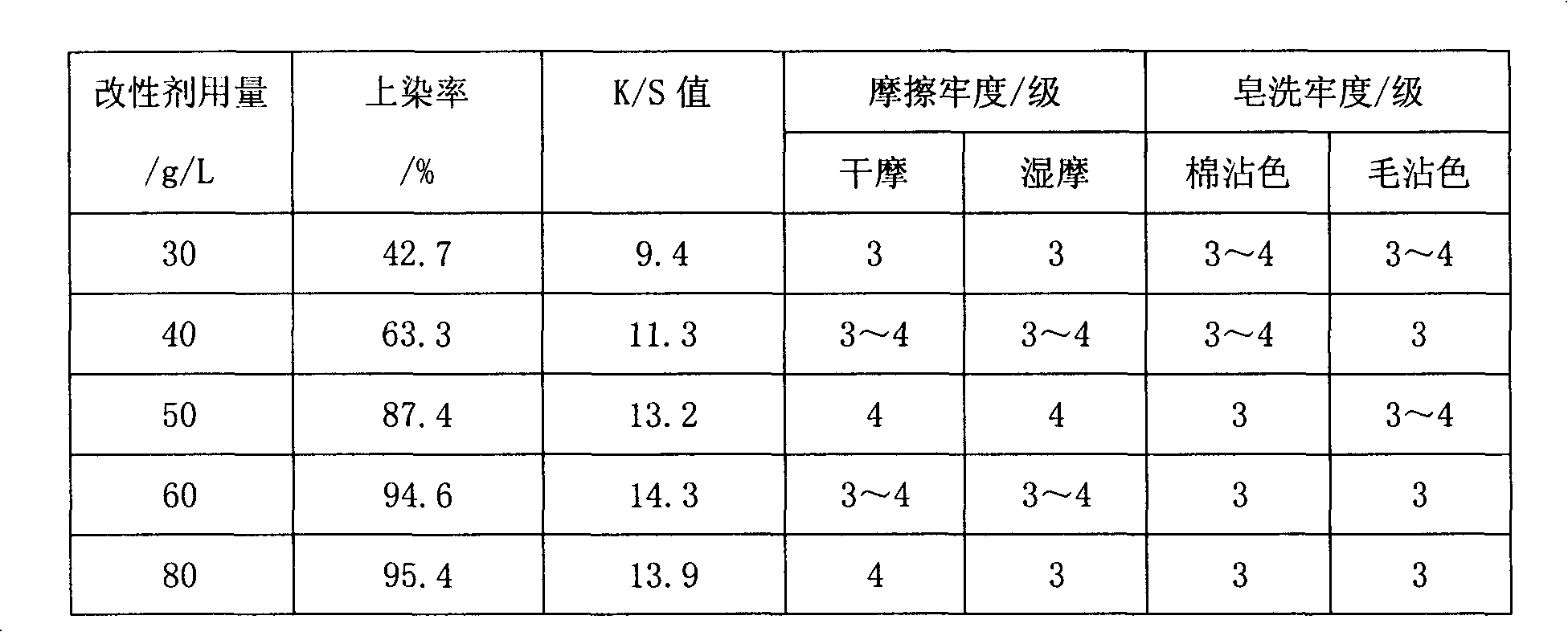Cellulose fiber cation modifier, preparing method and usage thereof
A cationic modifier and cellulose fiber technology, which is applied in fiber treatment, plant fiber, chemical instruments and methods, etc., can solve the problems of low dyeing rate of reactive dyes, low dye exhaustion rate, difficult sewage treatment, etc., to achieve Improve fabric hand feeling and good dyeing performance
- Summary
- Abstract
- Description
- Claims
- Application Information
AI Technical Summary
Benefits of technology
Problems solved by technology
Method used
Image
Examples
Embodiment 2
[0026] Fabric: Pure cotton bleached cloth
[0027] Dye: reactive red X-3B
[0028] Configuration of cationic modification solution and cationic modification of cotton fabric:
[0029] Dissolve 80 parts of cationic modifier in 1000 parts of water, add 34 parts of NaOH (or potassium hydroxide) after the solution is clarified, stir to dissolve and clarify. Put in 33 parts of fabric, set the temperature, keep warm at 60°C-90°C for 1-1.5h, take out the fabric, wash it with water, dry it, and set it aside.
[0030] Dyeing of modified cotton fabrics:
[0031] Dissolve 0.67 parts of reactive red X-3B in 1000 parts of water, put it into the modified cotton fabric, set the temperature, keep it warm at 60℃~90℃ for 0.5~1h, take out the fabric, soap and dry it.
Embodiment 3
[0033] Fabric: Pure cotton bleached cloth
[0034] Dye: Reactive Brilliant Blue X-BR
[0035] Configuration of cationic modification solution and cationic modification of cotton fabric:
[0036] Dissolve 30 parts of cationic modifier in 1000 parts of water, add 13 parts of NaOH after the solution is clarified, stir to dissolve and clarify. Put in 33 parts of fabric, set the temperature, keep warm at 60°C-90°C for 1-1.5h, take out the fabric, wash it with water, dry it, and set it aside.
[0037] Dyeing of modified cotton fabrics:
[0038] Dissolve 0.67 parts of Reactive Brilliant Blue X-BR in 1000 parts of water, put it into the modified cotton fabric, set the temperature, keep it warm at 60℃~90℃ for 0.5~1h, take out the fabric, soap and dry it.
Embodiment 4
[0040] Add 67 to 73 parts of concentrated hydrochloric acid with a mass fraction of 37% in a reactor equipped with an electric stirrer, dropping funnel, condenser and thermometer, and add 110 parts of a mass fraction of 33% trimethylamine aqueous solution dropwise under stirring conditions, and control The reaction temperature does not exceed 30°C, the dripping is completed in 1-1.5 hours, and the reaction is continued for 0.5-1 hour. After the reaction is completed, evaporate, crystallize and dry to obtain the intermediate trimethylamine hydrochloride.
[0041] Put 57 parts of the intermediate into the reactor, add 170-280 parts of absolute ethanol as a solvent, add 53-56 parts of epichlorohydrin into the dropping funnel, start the stirrer, and heat in a water bath. When the temperature rises to 40°C, start to add epichlorohydrin dropwise, finish dropping in 0.5 to 1 hour, and continue the reaction for 0.5 to 1 hour. After the reaction was completed, it was vacuum filtered a...
PUM
 Login to View More
Login to View More Abstract
Description
Claims
Application Information
 Login to View More
Login to View More - R&D
- Intellectual Property
- Life Sciences
- Materials
- Tech Scout
- Unparalleled Data Quality
- Higher Quality Content
- 60% Fewer Hallucinations
Browse by: Latest US Patents, China's latest patents, Technical Efficacy Thesaurus, Application Domain, Technology Topic, Popular Technical Reports.
© 2025 PatSnap. All rights reserved.Legal|Privacy policy|Modern Slavery Act Transparency Statement|Sitemap|About US| Contact US: help@patsnap.com

